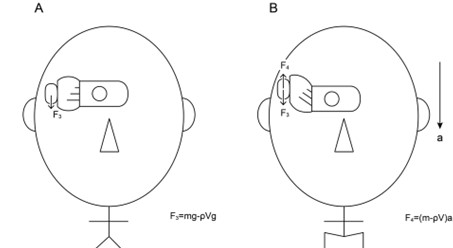Reevaluating the Role of Otolith Organs in Nystagmus Generation: An Experimental Approach
Abstract
This study investigates whether the otolith organs—the utricle and saccule—are involved in generating nystagmus. Using both human subject experiments (sway and squat tests) and inertial physical models, we demonstrate that linear accelerations do not produce nystagmus, challenging the prevailing view of an otolith-ocular reflex. Our results suggest that nystagmus is primarily mediated by the semicircular canals, while the otolith organs remain essential for body balance and gravity sensing. These findings prompt a reevaluation of vestibular reflex pathways and highlight the need for further investigation into vestibular physiology.
References
[2] Goto, F., et al. (2003). Eye movements evoked by the selective stimulation of the utricular nerve in cats. Auris Nasus Larynx, 30(4), 341-348. https://doi.org/10.1016/j.anl.2003.07.003
[3] Furman, J. M., et al. (1992). Off-vertical axis rotation: A test of the otolith-ocular reflex. Annals of Otology, Rhinology & Laryngology, 101(8), 643-650. https://doi.org/10.1177/000348949210100803
[4] Epley, J. M. (1992). The canalith repositioning procedure: For treatment of benign paroxysmal positional vertigo. Otolaryngology–Head and Neck Surgery, 107(3), 399-404. https://doi.org/10.1177/019459989210700310
[5] Murofushi, T., et al. (2015). Frequency preference in cervical vestibular evoked myogenic potential of idiopathic otolithic vertigo patients. Does it reflect otolithic endolymphatic hydrops? Acta Oto-Laryngologica, 135(10), 995-999. https://doi.org/10.3109/00016489.2015.1022834
[6] Ichijo, H. (2023). Affected-ear-up 90° maneuver proves that nystagmus does not occur by the stimulation to the macula of the utricle. Journal of Biosciences and Medicines, 11(5), 144-150. https://doi.org/10.4236/jbm.2023.115009
[7] Ikeda, T., et al. (2002). Simple eye movement image analysis technique using NIH image. Equilibrium Research, 61, 90-96. https://doi.org/10.3757/jser.61.90
[8] YouTube. (n.d.). Otolith Ocular Reflex. Retrieved from https://www.youtube.com/watch?v=p5pOOieLdD4&t=10s
[9] Ramos de Miguel, et al. (2020). The superiority of the otolith system. Audiology and Neurotology, 25(1-2), 35-41. https://doi.org/10.1159/000504595
[10] Darlot, C., et al. (2004). Eye movements induced by off-vertical axis rotation (OVAR) at small angles of tilt. Experimental Brain Research, 73, 91-105. https://doi.org/10.1007/BF00279664
[11] Sadeghpour, S., et al. (2021). Evaluation of the video ocular counter-roll (vOCR) as a new clinical test of otolith function in peripheral vestibulopathy. JAMA Otolaryngology–Head & Neck Surgery, 147(6), 518-525. https://doi.org/10.1001/jamaoto.2021.0176
[12] Ichijo, H. (2023). Eye movements induced by stimulation of the utricle. Journal of Otolaryngology and Rhinology, 9, 133. https://doi.org/10.23937/2572-4193.1510133


This work is licensed under a Creative Commons Attribution 4.0 International License.
Copyright for this article is retained by the author(s), with first publication rights granted to the journal.
This is an open-access article distributed under the terms and conditions of the Creative Commons Attribution license (http://creativecommons.org/licenses/by/4.0/).









1.png)














